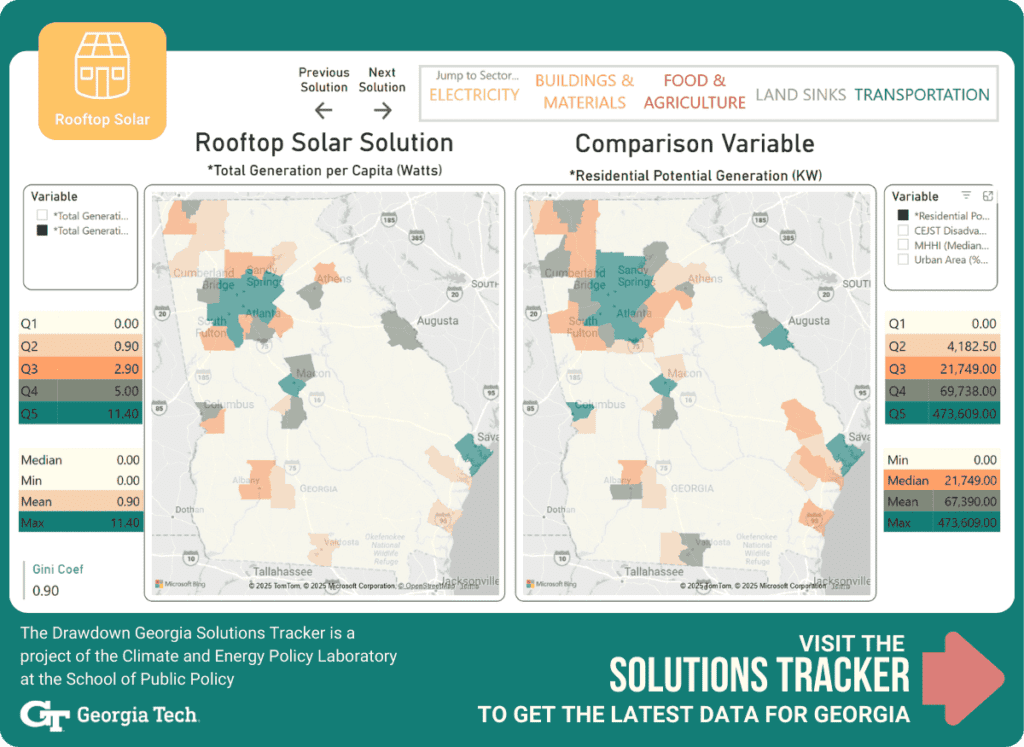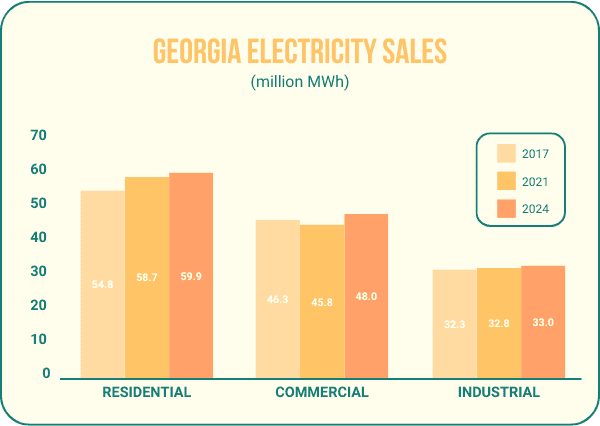The Benefits of Rooftop Solar
Solar photovoltaic systems convert solar energy into electricity. Rooftop solar systems are small-scale installations that produce electricity primarily for on-site use. When combined with battery storage, additional benefits accrue.
Rooftop solar produces clean, renewable energy, replacing the need for electricity generated from fossil fuels.
Access Rooftop Solar Resources from Drawdown Georgia
Market Readiness And Available Technology
The technology is mature and in Georgia, the United States, and globally, rooftop solar is market-ready and rapidly growing. With technology breakthroughs and cost reductions from “learning by doing,” costs are rapidly declining. The average cost of solar panels in Georgia in 2025 is $3.06 per watt, making a typical 6000-watt (6 kW) solar system $10,908 after claiming the 30% federal solar tax credit now available (information subject to change).
Modern solar panels are now lighter and designed for simpler installation, reducing the need for complex rewiring or additional hardware, enabling one-day installations. Improvements in battery technology are increasing the feasibility of home energy storage, allowing homeowners to maximize self-consumption of solar energy and reduce dependence on the grid.
Despite these advancements, rooftop solar adoption in Georgia remains slow compared to its technical potential. A study led by Dr. Marilyn Brown highlights that while rooftop photovoltaics (PV) could significantly contribute to Georgia’s clean energy mix, a 92% gap exists between the technically possible and the realistically achievable potential for rooftop solar installations. This gap is due in large part to regulatory and economic barriers that favor utility-scale solar over distributed rooftop systems.
Rooftop Solar as a Climate Solution in Georgia
The Drawdown Georgia research team estimates that Georgia could reduce emissions by one megaton (Mt) of CO2e by adding 295,000 new 5-kW home solar systems.
What is the Carbon Emissions Reduction Potential by 2030?
Achievable reduction potential is derived by taking the technical reduction potential, outlined below, and developing a more realistic forecast that takes current rates of deployment, market constraints, and other barriers into consideration.
For rooftop solar, the Drawdown Georgia research team has calculated the achievable reduction potential to be 0.64 Mt of CO2e.
What Is the Upper Limit of Carbon Emissions Reduction Potential?
Technical reduction potential reflects the upper limit of emissions reductions for this solution without regard to the constraints that exist in the real world, such as economic or political considerations.
For rooftop solar, the Drawdown Georgia research team has calculated the technical reduction potential to be 12.1 Mt.
Progress on Rooftop Solar in Georgia
The market for rooftop solar in Georgia has grown. 100 MW of distributed generation (DG) solar will be procured across 2026 and 2027, but adoption still remains limited. In 2020, only 0.3% of Georgia’s households had rooftop solar, despite the fact that 60% of households in the state own their homes. While the number of solar system providers in Georgia has increased, helping drive down costs through economies of scale and competition, financial and regulatory barriers persist. The 30% federal investment tax credit (ITC) remains available to homeowners with tax liabilities (information subject to change), but state-level incentives are lacking.
At the end of Quarter 3, 2024, Georgia had 7,281 MW of installed solar on rooftops (residential and commercial).

Urban areas across Georgia account for most of the state’s rooftop solar installations, while many rural counties still have little to no adoption. Notably, Floyd County, northwest of Atlanta, has lower-than-expected rooftop solar adoption despite high technical potential. In contrast, Jones County, north of Macon, has a higher-than-expected level of rooftop solar despite its lower technical potential. This suggests that adoption patterns are influenced by more than just technical feasibility, with factors such as income levels, local policies, and awareness playing a significant role.
Solarize programs were successful in Decatur-Dekalb (850 program participants), Atlanta (1,418 program participants), Athens (1,002 program participants), Carrollton-Carroll (239 program participants), Newton-Morgan (231 program participants), Roswell (155 program participants), Middle Georgia (299 program participants), and Dunwoody (282 program participants).
At the end of Quarter 1 2024, there were 250 companies (50 Manufacturers, 87 Installers/Developers, 113 Others) in Georgia and 5,382 jobs supported by the solar industry in Georgia.
Challenges in Scaling Rooftop Solar
The primary barriers to rooftop solar adoption in Georgia stem from economic and policy challenges. The reduction in Georgia Power’s buyback rates between 2020 and 2023 made solar investments less financially viable for homeowners.
Although the 2023 rate adjustment to ~6.5 cents/kWh represents an improvement, it is still significantly below the full retail rate of electricity, making it difficult for homeowners to justify the upfront costs of solar installation.
The limited adoption of rooftop solar from 2020 to 2024 has led to a downward revision in the achievable potential, with the 10-year projection now replaced by a more conservative 5-year forecast.
Financing remains a major hurdle, particularly for lower- and moderate-income households that may not have the capital to invest in solar or the tax liabilities needed to take advantage of federal incentives. The absence of strong state-level policies, such as net metering or state tax credits, further limits adoption. Additionally, regulatory structures continue to favor centralized utility-scale solar, creating an uneven playing field for distributed generation.
How Reliable Is Our 2030 Estimate For This Drawdown Georgia Climate Solution?
Ample data are available for rooftop solar. NREL publishes solar radiation maps, and rigorous and numerous assessments of its performance in the United States and the Southeast are conducted.
In 2030, it is assumed that 388 tons of CO2 will be emitted per GWh of electricity generated in Georgia. At this projected carbon intensity, 1 MtCO2 could be avoided in 2030 by adding 2,580 GWh of zero-carbon electricity, according to the Georgia Tech National Energy Modeling System (GT-NEMS).
The median single-family home floor area in Georgia is 2,200 square feet. A 5-kW solar installation can use as little as 400 square feet and is therefore viable on the average home, assuming sufficient sunlight exposure and a sturdy roof. Assuming a capacity factor of 20% (or nearly 5 hours/day), a 5-kW rooftop system would generate 8.76 MWh/year. To generate 2,580 GWh of zero-carbon electricity in 2030 and displace 1 Mt CO2 would require 295,000 5-kW solar rooftops. Fewer new systems would be needed if the industry continues to experience improvements in the efficiency of rooftop solar systems.
The Solar Energy Industries Association (SEIA) ranks Georgia 7th in the country, with the potential to add as much as 3,602 MW of solar (including both large-scale and rooftop installations) over the next five years.
Changes in GHG Emissions from Electricity Consumption by Homes
Electricity consumption from households in Georgia rose from 2017 to 2023. However, CO2 emissions from the electricity consumed by Georgia households dropped significantly, due mostly to reductions in the carbon intensity of the fuels used to generate electricity.


Beyond Carbon Attributes
The environmental benefits of rooftop solar relate to air quality improvements from the reduction of fossil fuel pollution, particularly sulfur dioxide (a major contributor to acid rain), PM2.5 (particulate matter less than 2.5 micrometers in diameter, which poses a risk to respiratory health), and nitrogen oxides, which contribute to air pollution, in addition to CO2.
From an economic development standpoint, the construction and operation of solar solutions offer local and statewide employment. According to SEIA, there are 250 solar companies operating in Georgia. In 2023, there were 5,639 jobs in the solar industry in Georgia, representing a 52.6% growth rate from 2018 to 2023.
Rooftop PV systems with battery solutions have the potential to supply electricity during grid outages resulting from emergency situations, which offers benefits for electricity system resilience. Additionally, rooftop panels have been found to have a positive impact on property values.
Given the scale of current and potential solar panel installations, end-of-life disposability of PV panels is a pertinent environmental issue due to toxic materials contained within the cell, such as cadmium, arsenic, and silica dust. The US is expected to produce 170,000 tons of PV panel waste in 2030. In response to this problem, a new solar panel recycling industry is growing. The recycling company Solarcycle estimates they will be recycling 10 million solar panels per year by 2030 at a new Georgia facility, representing as much as 30% of all retired solar panels at that time.
In terms of potential adverse impacts related to equity and solution accessibility, Sunter et al. found significant racial and ethnic differences in rooftop solar adoption in the U.S., even after accounting for income and household ownership. NREL also analyzes the impact of rate design to recover fixed utility costs arising from lower net electricity consumption after residential PV penetration, which may exacerbate the “energy burden” experienced by lower-income households who, without access to solar, continue to purchase all of their electricity from the grid.
What is the Gini Coefficient for Rooftop Solar?
Rooftop solar is one of the most concentrated climate solutions in Georgia, with its adoption heavily skewed toward wealthier urban counties. The Gini coefficient for rooftop solar adoption in Georgia is 0.90, reflecting extreme inequality in its distribution. The majority of rooftop solar installations are located in affluent urban areas, while adoption remains limited in lower-income and rural communities. The highest per capita rooftop solar generation is in Cobb County at 11.40 Watts per person in 2020.
Efforts to address these disparities should include expanding access to community solar programs, increasing state-level incentives for residential solar, and implementing policies that support low-income participation. Programs like Solarize campaigns, which leverage bulk purchasing and community engagement to reduce costs, have shown promise in increasing adoption among first-mover communities.
However, broader policy changes, such as improved buyback rates and financing options, will be necessary to make rooftop solar a viable option for a larger share of Georgia’s population.



